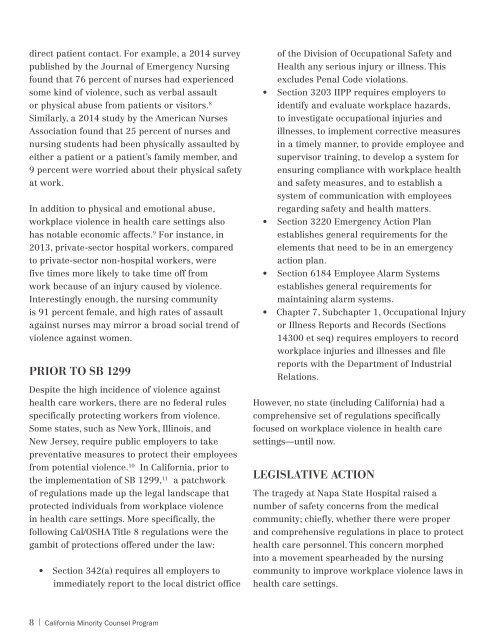CMCP Diversity Matters - May/June 2018
California Minority Counsel Program Diversity Matters - May/June 2018
California Minority Counsel Program Diversity Matters - May/June 2018
You also want an ePaper? Increase the reach of your titles
YUMPU automatically turns print PDFs into web optimized ePapers that Google loves.
direct patient contact. For example, a 2014 survey<br />
published by the Journal of Emergency Nursing<br />
found that 76 percent of nurses had experienced<br />
some kind of violence, such as verbal assault<br />
or physical abuse from patients or visitors. 8<br />
Similarly, a 2014 study by the American Nurses<br />
Association found that 25 percent of nurses and<br />
nursing students had been physically assaulted by<br />
either a patient or a patient’s family member, and<br />
9 percent were worried about their physical safety<br />
at work.<br />
In addition to physical and emotional abuse,<br />
workplace violence in health care settings also<br />
has notable economic affects. 9 For instance, in<br />
2013, private-sector hospital workers, compared<br />
to private-sector non-hospital workers, were<br />
five times more likely to take time off from<br />
work because of an injury caused by violence.<br />
Interestingly enough, the nursing community<br />
is 91 percent female, and high rates of assault<br />
against nurses may mirror a broad social trend of<br />
violence against women.<br />
PRIOR TO SB 1299<br />
Despite the high incidence of violence against<br />
health care workers, there are no federal rules<br />
specifically protecting workers from violence.<br />
Some states, such as New York, Illinois, and<br />
New Jersey, require public employers to take<br />
preventative measures to protect their employees<br />
from potential violence. 10 In California, prior to<br />
the implementation of SB 1299, 11 a patchwork<br />
of regulations made up the legal landscape that<br />
protected individuals from workplace violence<br />
in health care settings. More specifically, the<br />
following Cal/OSHA Title 8 regulations were the<br />
gambit of protections offered under the law:<br />
• Section 342(a) requires all employers to<br />
immediately report to the local district office<br />
of the Division of Occupational Safety and<br />
Health any serious injury or illness. This<br />
excludes Penal Code violations.<br />
• Section 3203 IIPP requires employers to<br />
identify and evaluate workplace hazards,<br />
to investigate occupational injuries and<br />
illnesses, to implement corrective measures<br />
in a timely manner, to provide employee and<br />
supervisor training, to develop a system for<br />
ensuring compliance with workplace health<br />
and safety measures, and to establish a<br />
system of communication with employees<br />
regarding safety and health matters.<br />
• Section 3220 Emergency Action Plan<br />
establishes general requirements for the<br />
elements that need to be in an emergency<br />
action plan.<br />
• Section 6184 Employee Alarm Systems<br />
establishes general requirements for<br />
maintaining alarm systems.<br />
• Chapter 7, Subchapter 1, Occupational Injury<br />
or Illness Reports and Records (Sections<br />
14300 et seq) requires employers to record<br />
workplace injuries and illnesses and file<br />
reports with the Department of Industrial<br />
Relations.<br />
However, no state (including California) had a<br />
comprehensive set of regulations specifically<br />
focused on workplace violence in health care<br />
settings—until now.<br />
LEGISLATIVE ACTION<br />
The tragedy at Napa State Hospital raised a<br />
number of safety concerns from the medical<br />
community; chiefly, whether there were proper<br />
and comprehensive regulations in place to protect<br />
health care personnel. This concern morphed<br />
into a movement spearheaded by the nursing<br />
community to improve workplace violence laws in<br />
health care settings.<br />
8 | California Minority Counsel Program

















